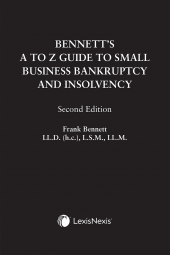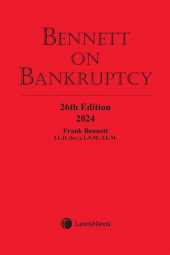Bennett's A to Z Guide to Small Business Bankruptcy and Insolvency, 2nd Edition
One Year Subscription Only Terms
Subscribers receive the product(s) listed on the Order Form and any Updates made available during the annual subscription period. Shipping and handling fees are not included in the annual price.
Subscribers are advised of the number of Updates that were made to the particular publication the prior year. The number of Updates may vary due to developments in the law and other publishing issues, but subscribers may use this as a rough estimate of future shipments. Subscribers may call Customer Support at 800-833-9844 for additional information.
Subscribers may cancel this subscription by: calling Customer Support at 800-833-9844; emailing customer.support@lexisnexis.com; or returning the invoice marked 'CANCEL'.
If subscribers cancel within 30 days after the product is ordered or received and return the product at their expense, then they will receive a full credit of the price for the annual subscription.
If subscribers cancel between 31 and 60 days after the invoice date and return the product at their expense, then they will receive a 5/6th credit of the price for the annual subscription. No credit will be given for cancellations more than 60 days after the invoice date. To receive any credit, subscriber must return all product(s) shipped during the year at their expense within the applicable cancellation period listed above.
Détails des produits
Bennett’s A to Z Guide to Small Business Bankruptcy and Insolvency, 2nd Edition is a practical guide for lawyers, accountants, trustees, and lenders regarding the complete bankruptcy process. Written by bankruptcy and insolvency expert Frank Bennett, the second edition includes up-to-date key legislative changes since the first edition published over 20 years ago.
In one handy and indispensable bankruptcy primer, readers of this new edition will find straightforward information on:
- The major steps in the bankruptcy and proposal routes, including flowcharts, and providing an overview of the different stages
- The duties of a bankrupt and the roles of the trustee, registrar and creditors
- The distribution of a bankrupt’s property and exempt property
- The property that a bankrupt is allowed to keep
- The debts that survive bankruptcy
- The disadvantages of bankruptcy and how to help your client avoid it
- Common questions clients ask, such as:
- Who Prepares the Debtor’s Income Tax Returns?
- Is Notice of the Debtor’s Bankruptcy in the Newspaper?
- Can Creditors Continue to Call on the Debtor for Payment After Bankruptcy?
- Will the Debtor’s Employer Find Out About the Bankruptcy?
- Is the Debtor’s Credit Rating Affected?
- What Happens to the Debtor’s Bank Accounts?
- Where Can the Debtor Acquire Better Budgeting Skills?
- Can the Debtor Get a Loan After Bankruptcy?
- Are the Assets of the Debtor’s Spouse Affected?
- Where Does the Debtor Find a Bankruptcy Lawyer? A Trustee?
- Does the Debtor Have any Director’s Liabilities?
- Can the Debtor Keep the Car After Bankruptcy?
Features of This Book
Bennett’s A to Z Guide to Small Business Bankruptcy and Insolvency, 2nd Edition features a complete set of precedents plus a helpful glossary of terms, covering everything from “Application for a Bankruptcy Order” to “Writ of Seizure and Sale”. It also includes more than 30 forms designed to guide practitioners through the bankruptcy process, such as:
- Statement of Affairs – Business and Non-Business
- Resolution of Directors
- Bankruptcy Order
- Third Party Guarantee
- Notice to Creditors of First Meeting
- Proof of Claim
- Notice of Impending Automatic Discharge of First-Time Bankrupt
- Affidavit of Earnings
- Notice to Creditors of Consumer Proposal
- Plus many more
Who Should Read This Book
Written from a practitioner's point of view, this new edition is perfect for:
- Bankruptcy and Insolvency Lawyers
- Corporate and Commercial Lawyers
- Lenders including banks, trust companies, syndicated lending associations
- Trustees, Receivers, Monitors, Accountants, Debtors, Directors and Officers
- Credit Counsellors
- Corporate Secretaries, and In-House Corporate Counsel
- Government agencies
- Small business owners
- Professionals and self-employed
Table des matières
Preface
Chapter 1: What is Bankruptcy?
Chapter 2: Who are the Persons Involved in the Bankruptcy Process?
Chapter 3: What are the Major Steps in the Bankruptcy Process?
Chapter 4: What Does the Trustee Do?
Chapter 5: What are the Types of Creditors in a Bankruptcy?
Chapter 6: What Property Can the Debtor Keep?
Chapter 7: What Debts Survive After Bankruptcy?
Chapter 8: What are the Bankrupt’s Duties?
Chapter 9: How Does the Bankrupt Get Out of Bankruptcy?
Chapter 10: What Are the Disadvantages to Bankruptcy?
Chapter 11: The Debtor is Ready to File
Chapter 12: Some Common Questions
Chapter 13: Is Bankruptcy the Best Solution?
Chapter 14: Should the Debtor Learn More?
Chapter 15: Glossary of Terms
Chapter 16: A Complete Set of Forms
Chapter 17: Excerpts From the Bankruptcy and Insolvency Act
 Lexis Nexis
Lexis Nexis 


